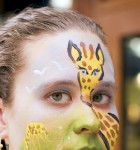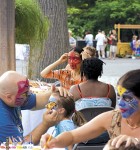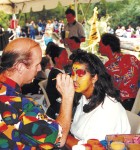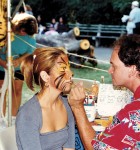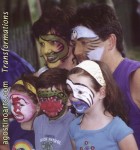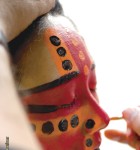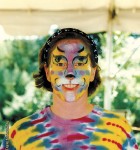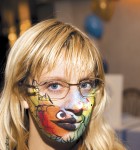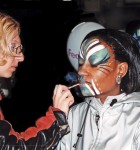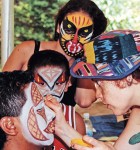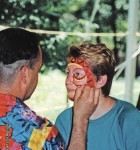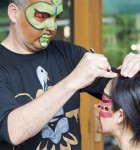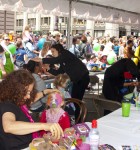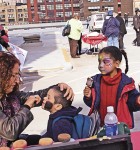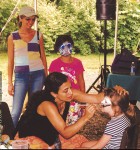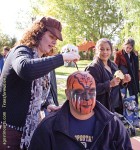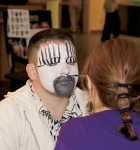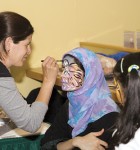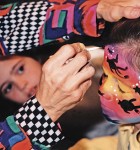About the Company
— adapted from Transformations! The Story behind the Painted Faces by Christopher Agostino – revised 12/12/12
The first face I painted was in 1976, as a young actor asked to help turn hundreds of my fellow high school students into clowns for a bicentennial parade. By the next summer, the members of our theater troupe had opened a facepainting concession at Adventureland Amusement Park on Long Island, NY. I haven’t stopped painting faces since. (Why would I? It’s too much fun).
In the eighties I began to look at facepainting differently — as an art. The art of transformation. In 1983 I was in LA, painting faces and bodies at Venice Beach. I joined with another performer and visual artist, Jennifer Green, to promote facepainting to museums and art shows as well as the usual gigs. Jenn’s approach to a face was very different from mine. On the same day that I painted a classic Chinese Opera design on her as a logo for our fledgeling company, she turned me into abstract art.
When I returned to New York, I got a gig painting faces in the window of Unique Clothing right on Broadway in Greenwich Village and worked there on and off through the mid- ‘80s. It was facepainting as public entertainment. As was the case at both the amusement park and Venice Beach, I was painting more adults and teens than kids. I worked on ways to blend my theatrical approach and the Chinese Opera imagery with the punk styles people were wearing on the streets.
The extensive event industry in New York let me move from street fairs, where people paid for each face, to being hired for private parties and corporate events. Sometimes I’d be able to bring along another artist who painted full faces, but most often there would be other freelance facepainters on these gigs with their own styles or just doing cheek art.
As the work became more steady and the events larger, I wanted to always work with a group of artists who approached this art like I did, to present facepainting as more than a cute diversion for little kids. That led in the ‘90s to the formation of the company, Transformations Facepainting, and that was when facepainting really became fun.
Finding a facepainting home like the Bronx Zoo has allowed us to develop and maintain a company of very experienced artists. The members of Transformations Facepainting, over the years, have included: Dennis Pettas, Roberta Halpern, Jennifer Wade, Miguel Cossio, Laura Metzinger, Michele Carlo, Angela Izrailova, Miko and Claudia Reese, Jin Young Park, Danny Gosnell, Naoko Oshima, Margery Gosnell-Qua, Maria Pirone, Sigfrido Aguilar, Janet Izzo, Denise Lord, Nirupama Kumar, Christine Gregory, Zak Brown, Lizi Costache, Regina Russo, Phil Zirkuli, Britt Lower, Colleen Gallagher, Deborah Berkson, Abigail Weg. Our website and promotional materials are full of my snapshots of the faces that I paint — their work is vastly under-represented in proportion to their contribution to the success of our company.
The artists who find their way into our company tend to stay with us. It’s so much fun and we like each other.
Before I had an organized troupe, I had friends to paint with. I’d get canvas painters I knew, like Wanda Boudreaux, to try facepainting. Wanda’s from New Orleans, so we also got a chance to paint down there for Mardi Gras, and I have always felt that I learned as much from artists like Wanda as they learned from me. Some of the other artists I’ve painted with along the way include Kate Cain Madsen (who began like me back at Adventureland), Teddy Goldman, Anne Farmer, Diane Epstein, Suzanne Haring and her sisters, Jodi Levitan, Susan-Rachel Condon, Luanne Dietrich, Erica Borillo, and Therese Schorn. Some of these artists were with me as I first began to discover what I wanted to do with a face.
A facepainter is an artist who entertains, and entertainers get into the most interesting places. One day we may be painting at a party in the inner recesses of the New York Stock Exchange and the next day we’re painting an endless line of kids in the Bronx for the NYC Parks Department. One summer, Transformations was hired by the Nature Conservancy for the Long Island Beach Festival. It was a wonderful event, right on the beach at Smiths Point Park. I got to tell stories and talk about nature and facepainting to the crowd strolling through the tent, and we got a chance to dip our toes in the ocean afterwards. This is a wonderful business.
Usually for such events I’ll give the artists a theme and maybe some source images like masks or sea life photos and they will invent their own faces. This time I tried something different. I gave to the three artists working with me (Naoko, Marge and Miguel), a set of 70 sea life faces I had sketched out for an earlier project at the New York Aquarium and asked them for that day to use my designs rather than their own. We told the crowd we were painting not to worry about what they wanted to be, that everyone would be surprised with a different sea life face.
As these three accomplished artists, who I have worked beside for years, began painting my face designs each took their own approach, brought their own style and vision, and none of the faces looked like I’d painted them. What a pleasure it was to work beside them.
For such artists to believe me when I tell them what I think is possible in this unconventional medium; for them to let me give them certain rules for painting on certain days; for colleagues to let me set a course for their creativity — this is all a very unexpected consequence of my decision to be a facepainter. To have a company of artists who want to do what I do amazes me.
 ‘Tis the season… We do a lot of Halloween and Fall festival events this time of year, and folks seem even more appreciative of, and open to, our creativity as Halloween approaches. It’s a good time to develop new face ideas and expand on older ones. Our approach is to surprise each person we paint with an original design just for them, only asking if they want to be “nice” or “spooky” — or matching their costume if they have one. Here’s a gallery of some of my favorites as I paint this season, and I’ll add more as we go (gallery updated 10/23/13). Mostly they are the spooky ones, but there’s a few nice ones as well. Check out our event schedule on the News/Schedule page and come and be transformed at Boo at the Zoo and our other Fall Festival and Halloween events.
‘Tis the season… We do a lot of Halloween and Fall festival events this time of year, and folks seem even more appreciative of, and open to, our creativity as Halloween approaches. It’s a good time to develop new face ideas and expand on older ones. Our approach is to surprise each person we paint with an original design just for them, only asking if they want to be “nice” or “spooky” — or matching their costume if they have one. Here’s a gallery of some of my favorites as I paint this season, and I’ll add more as we go (gallery updated 10/23/13). Mostly they are the spooky ones, but there’s a few nice ones as well. Check out our event schedule on the News/Schedule page and come and be transformed at Boo at the Zoo and our other Fall Festival and Halloween events.









































